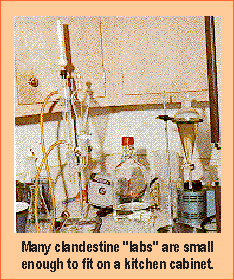
DRCNet Response to the
Drug Enforcement Administration

![]()
DRCNet Response to the
Drug Enforcement Administration
 Drugs of abuse in the United States come from a
variety of sources. Heroin and cocaine, for example, are produced in foreign countries and
smuggled into the United States. Marijuana is cultivated domestically or smuggled from
foreign sources. Legitimate pharmaceuticals are diverted to the illicit market. Continuing
efforts on the part of state and federal governments to reduce the amount of dangerous and
illicit drugs available for abuse, combined with the demand for psychoactive substances,
have contributed to the proliferation of clandestine laboratories.
Drugs of abuse in the United States come from a
variety of sources. Heroin and cocaine, for example, are produced in foreign countries and
smuggled into the United States. Marijuana is cultivated domestically or smuggled from
foreign sources. Legitimate pharmaceuticals are diverted to the illicit market. Continuing
efforts on the part of state and federal governments to reduce the amount of dangerous and
illicit drugs available for abuse, combined with the demand for psychoactive substances,
have contributed to the proliferation of clandestine laboratories.
Clandestine laboratories are illicit operations consisting of chemicals and equipment necessary to manufacture controlled substances. The types and numbers of laboratories seized, to a large degree, reflect regional and national trends in the types and amounts of illicit substances that are being manufactured, trafficked and abused. Clandestine laboratories have been found in remote locations like mountain cabins and rural farms. Laboratories are also being operated in single and multifamily residences in urban and suburban neighborhoods where their toxic and explosive fumes can pose a significant threat to the health and safety of local residents.
 The production of some substances, such as
methamphetamine , PCP. MDMA and methcathinone, requires little sophisticated equipment or
knowledge of chemistry; the synthesis of other drugs, such as fentanyl and LSD, requires
much higher levels of expertise and equipment. Some clandestine laboratory operators have
little or no training in chemistry and follow underground recipes; others employ chemistry
students or professionals as "cooks."
The production of some substances, such as
methamphetamine , PCP. MDMA and methcathinone, requires little sophisticated equipment or
knowledge of chemistry; the synthesis of other drugs, such as fentanyl and LSD, requires
much higher levels of expertise and equipment. Some clandestine laboratory operators have
little or no training in chemistry and follow underground recipes; others employ chemistry
students or professionals as "cooks."
The clandestine production of all drugs is dependent on the availability of essential
raw materials. The distribution, sale, import and export of certain chemicals which are
important to the manufacture of common illicitly produced substances have been regulated
since the enactment of the Chemical Diversion and Trafficking Act of 1988. Enforcement of
this and similar state laws has had a significant impact on the availability of chemicals
to the clandestine laboratory.
Travel back to the DRCNet Response to the DEA Home Page
Travel back to the DRCNet Response to the DEA Publications List
Travel back to the Drugs of Abuse Table of Contents
Travel back to the Drugs of Abuse Related Topics Chapter